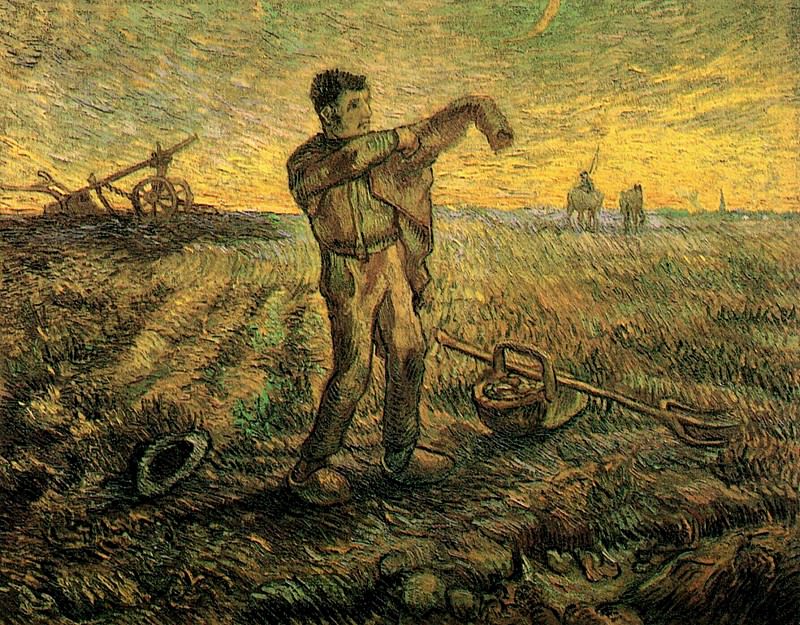Evening – The End of the Day (after Millet) Vincent van Gogh (1853-1890)
Vincent van Gogh – Evening - The End of the Day (after Millet)
Edit attribution
Download full size: 1785×1393 px (0,3 Mb)
Painter: Vincent van Gogh
Location: Menard Art Museum, Komaki.
"Evening: End of Day" is one of a hundred and fifty paintings Van Gogh created during the last year of his life. It was influenced by a sketch of the same name by Jean-François Millet. Working with Millet’s black-and-white sketches alone, Van Gogh produced twenty-three paintings in those months. The artist did not consider the transfer of Millet’s drawings on wood or canvas as copying. He called it a translation into the language of colors, impressions, shades of light. Talking about the work on the painting, Van Gogh said that he uses sketches of Millais as a common subject of life.
Description of Vincent van Gogh’s painting "Evening: End of Day"
"Evening: End of Day" is one of a hundred and fifty paintings Van Gogh created during the last year of his life. It was influenced by a sketch of the same name by Jean-François Millet. Working with Millet’s black-and-white sketches alone, Van Gogh produced twenty-three paintings in those months.
The artist did not consider the transfer of Millet’s drawings on wood or canvas as copying. He called it a translation into the language of colors, impressions, shades of light.
Talking about the work on the painting, Van Gogh said that he uses sketches of Millais as a common subject of life. And then the improvisation over light begins. In part, the light, according to Van Gogh, is "recalled" from the original. Such "recalling" is the author’s interpretation of the painting.
One of the central figures in Van Gogh’s work of the period was the priest. The grim Priest, interrupting the usual cycle of nature. Rather, the painting in question depicts a sower who has finished his work and is going home.
The painting is not an exact copy of Millais’ work. Only the subject is taken. Here a completely different field, on the ground lie other tools. The image of the worker is also different - we see the usual tired man after a long day at work, trying to pull on a shabby jacket and barely got his left hand into the sleeve.
When working with such black and white reproductions, the artist not only develops a unique color scheme. He also highlights shapes. As he does with real models, he looks for "knotty and broad lines."
Van Gogh himself believed that such copying could do more good than his own painting classes. It is known that he only managed to sell one painting in his lifetime. Ironically, a century later, his paintings are going for tens of millions of dollars.
The painting is part of the permanent exhibition of the famous Japanese art gallery Menar.
Кому понравилось
Пожалуйста, подождите
На эту операцию может потребоваться несколько секунд.
Информация появится в новом окне,
если открытие новых окон не запрещено в настройках вашего браузера.
You need to login
Для работы с коллекциями – пожалуйста, войдите в аккаунт (open in new window).




















COMMENTS: 1 Ответы
Вечером: конец дня. худ. Ван Гог.
Жан Франсуа Миле,
Которого картины
О том, как на земле,
Не разгибая спины,
Чтоб прокормить семью,
Все трудятся крестьяне,
Почти всю жизнь свою,
Мэтра привлек вниманье.
Он копию создаст
Простой картины этой,
Где четко передаст
Особенность сюжета
Уже на свой манер,
Работая над светом,
И изменив размер,
Преуспевает в этом.
Другое поле здесь,
Другие инструменты
Лежат на поле. Есть
И схожие фрагменты.
Мужчина, например:
Он куртку одевая
На собственный манер,
В рукав чуть попадает.
Он очень утомлен
Пора идти до дома
Работою пленен,
Что с детства так знакома.
Сосед на лошадях
Уже маячи где-то.
Людей здесь, на полях,
Не будет до рассвета.
You cannot comment Why?